5 Unusual Technolgy Innovations Of The Solar Cells That Will Change The Future
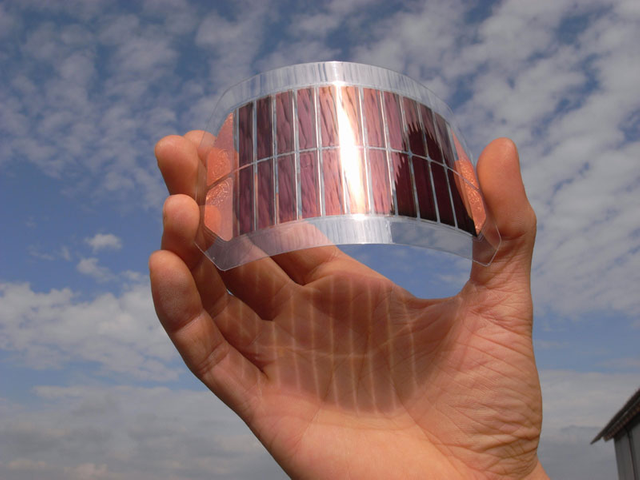
To date, silicon-based solar cells are far from the final path to curb the energy of sunlight and transform it into useful electrical energy. Many works are conducted by scientists till now, and in this article we will consider five unusual solutions, developed by some of the modern researchers.
The US National Renewable Energy Laboratory (NREL) has built a solar battery based on semiconductor crystals, whose dimensions do not exceed several nanometers, these are the so-called quantum dots. The sample is already a record for the indicators of external and internal quantum efficiency, which were respectively 114% and 130%.
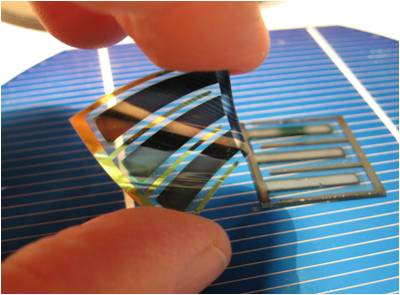
These characteristics show the ratio of the number of electron-hole pairs generated to the number of photons incident on the sample (external quantum efficiency) and the ratio of the number of generated electrons to the number of absorbed photons (internal quantum efficiency) for a certain frequency.
The external quantum efficiency is less than internal, since not all of the absorbed photons participate in the generation, and some of the photons incident on the panel are simply reflected.
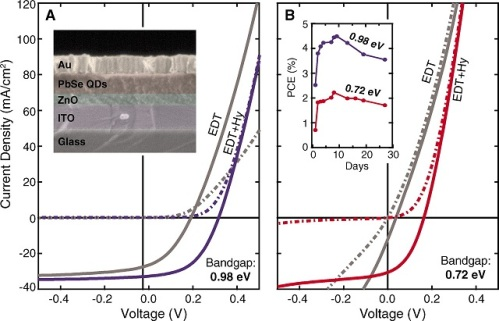
The sample consists of the following parts: glass in the antireflection coating, transparent conductor layer, then nanostructured layers of zinc oxide and lead selenide quantum dots, then ethanedithiol and hydrazine, and as the upper electrode a thin layer of gold.
The total efficiency of such a cell is about 4.5%, but this is sufficient for the experimentally obtained sufficiently high quantum efficiency of this combination of materials, and hence optimization and improvement ahead.
Yet no solar cell has shown an external quantum efficiency of more than 100%, while the uniqueness of this NREL development is that each photon that has fallen on a battery generates more than one electron-hole pair at the output.
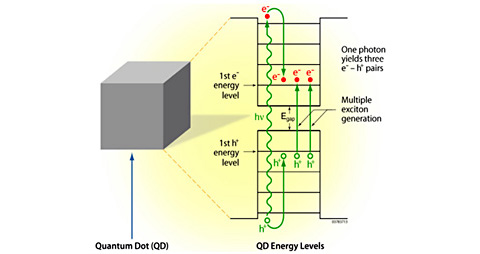
The reason for the success was the multiple generation of excitons (MEG), an effect that was first used to create a full-fledged solar cell capable of generating electricity. The intensity of the effect is related to the parameters of the material, with the width of the band gap in the semiconductor, and also with the energy of the incident photon.
Of decisive importance is the size of the crystal, since it is within a tiny volume that quantum dots limit the charge carriers and can collect excess energy, otherwise this energy would simply be lost in the form of heat.
In the laboratory, it is believed that elements based on the MEG effect are very worthy candidates for the new generation of solar cells.
Another priceless approach to the creation of solar batteries offered Prashant Kamat from the University of Notre Dame. His team developed a paint based on quantum dots of titanium dioxide, coated with cadmium sulfide and cadmium selenide, in the form of a water-alcohol mixture.
The paste was applied to a plate of glass with a conductive layer, then a roasting was carried out, and as a result, a photovoltaic battery was obtained. The substrate, converted into a photovoltaic panel, requires only an electrode from above, and it is possible to obtain an electric current by placing it in the sun.
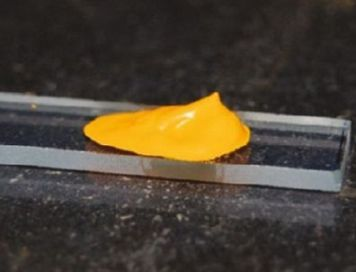
Scientists believe that in the future it will be possible to create paint for cars and for houses, and thus turn, say, the roof of the house, or the car body, painted with this special paint, into solar panels. This is the main goal of the researchers.
Although the efficiency is not high, only 1%, which is 15 times smaller than conventional silicon panels, solar paint can be produced in large volumes, and very inexpensively. So, energy needs in the future can be met, say chemists from the Kamat group, who call their offspring "Sun-Believable", which in translation means "Sunny Probable."
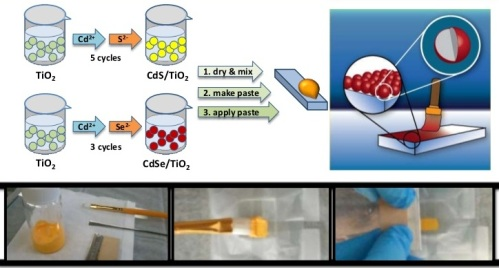
The next unusual way of converting solar energy is offered at the Massachusetts Institute of Technology. Andreas Mershin and colleagues created experimental batteries based on a complex of biological molecules capable of "collecting" light.
Photo-system PS-1, borrowed from the cyanobacterium Thermosynechococcus elongatus, was proposed by the molecular biologist Shuguang Zhang and several like-minded people 8 years before the start of the current experiments by Andreas Mershin.
The efficiency of the systems turned out to be only about 0.1%, but this is an important step towards mass introduction into everyday life, because the costs of creating such devices are extremely low, and in general, biological batteries can be created by their owners using a set of chemical reagents and a stack of freshly cut grass . Meanwhile, a number of improvements will allow to increase the efficiency up to 1-2%, i.е. to a commercially viable level.
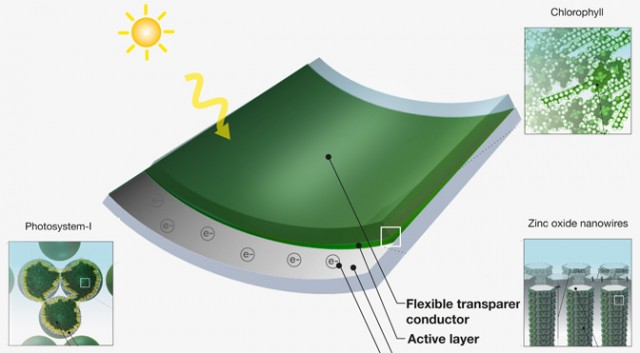
Previous similar cells with photosystems could work only under laser light, concentrated strictly on the cell, and then only in a narrow wavelength range. In addition, expensive chemicals and laboratory conditions were needed.
Another problem was that the molecular complexes extracted from plants could not exist for long. Now the team of the institute has developed a set of surface active peptides enveloping the system and preserving it for a long time.
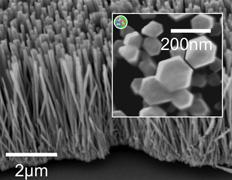
By increasing the efficiency of light collection, the team at the Massachusetts Institute of Technology decided to protect the photosystem from ultraviolet radiation, which previously damaged the photosystem.
PS-1 was now sown not on a smooth substrate, but on a surface with a very large effective area, these were titanium dioxide tubes 3.8 μm thick with pores at 60 nm, and dense zinc oxide rods several meters in height and several hundred nanometers in diameter .
These variants of the photoanode allowed to increase the number of chlorophyll molecules under light, and protected the PS-1 complexes from ultraviolet rays, since both materials absorb them well. In addition, titanium tubes and zinc rods also play the role of the carcass and act as carriers of electrons, while PS-1 collects light, assimilates it, and separates charges, as it does in living cells.
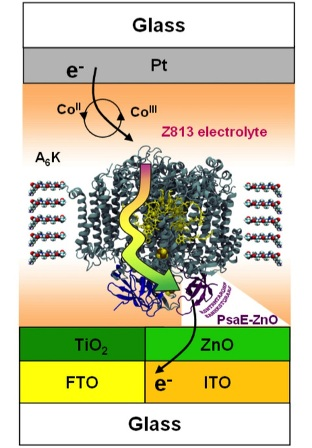
The cell exposed to the sun gave a voltage of 0.5 volts at a specific power of 81 microwatts per square centimeter and a photocurrent density of 362 μA per square centimeter, which is 10 times higher than any other previously known bio-photovoltaics based on natural photosystems.
Now let's talk about solar batteries based on organic polymers. If they are mass-produced, they will be much cheaper than silicon competitors, while the efficiency is already 10.9%. The tandem polymer solar battery, created by a group of scientists from the University of California at Los Angeles (UCLA), has several layers, each of which works with its part of the spectrum.
A successful combination of different substances that do not interfere with each other when working together is the most important point. It is for this purpose that the authors specially developed conjugated polymers with a low forbidden band.
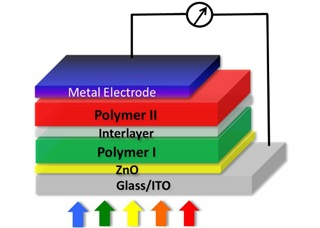
In 2011, scientists managed to obtain such a single-layer polymer cell with an efficiency of 6%, while a tandem cell showed an efficiency of 8.62%. Working further, the researchers set out to expand the range of the working spectrum to the infrared region, and they had to add the polymer of the Japanese company Sumitomo Chemical, thanks to which the efficiency was reached 10.9%.
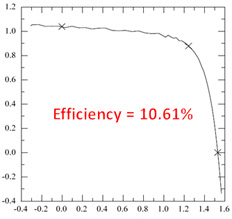
This most successful design consists of a front cell made of material with a large forbidden zone, and from a back cell in which the forbidden zone is narrow. The authors of the development claim that the creation of such a converter, including the cost of materials, is not very expensive, in addition, the technology itself is compatible with today's produced thin-film solar batteries.
It seems that in the next few years solar cells based on organic polymers will become commercially viable, because the developers plan to increase their efficiency up to 15%, that is, to the level of silicon.
Finish the review of super thin solar cells, having a thickness of 1.9 microns, which is 10 times thinner than any other previously created thin-film batteries. Joint efforts of Japanese and Austrian scientists, created a thin organic extraordinarily flexible solar battery. At the demonstration, the product was wrapped around a human hair with a diameter of 70 μm.
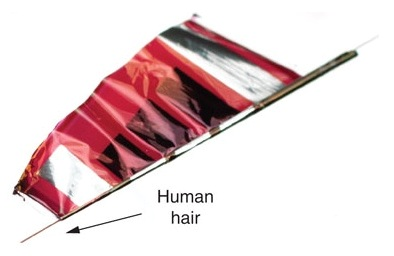
Traditional batteries were used to fabricate the battery, but the substrate was made of polyethylene terephthalate 1.4 μm thick. With an efficiency of 4.2%, the specific power of the new solar battery was 10 watts per gram, which is 1000 times more than the corresponding indicator of batteries based on multicrystalline silicon.
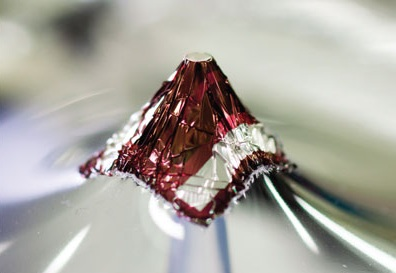
In this regard, it seems promising development of such areas as "smart textiles" and "smart skin", where in addition to solar batteries can be present and electronic microchips created by a similar technology, are also subtle and flexible.
References for Text and Images:
- https://www.extremetech.com/extreme/116689-mit-creates-solar-cell-from-grass-clippings
- http://sinovoltaics.com/solar-basics/solar-cell-guide-part-4-organic-and-dye-sensitized-solar-cells/
- https://sourceable.net/organic-solar-cells-get-efficiency-boost/
- http://www.newsweek.com/indoor-solar-cells-made-possible-moth-eye-graphene-breakthrough-430827
- http://news.mit.edu/2012/hybrid-flexible-light-solar-cells-1221
- https://3dprint.com/177171/solar-cell-3d-printer-usage/
- http://www.innovationtoronto.com/2017/10/fractal-like-concentrating-solar-power-receivers-are-20-percent-better-at-absorbing-sunlight/
- https://science.howstuffworks.com/environmental/green-science/thin-film-solar-cell.htm
Support @steemstem and the #steemstem
project - curating and supporting quality STEM
related content on Steemit

Being A SteemStem Member
You have collected your daily Power Up! This post received an upvote worth of 2.7$.

Learn how to Power Up Smart here!
This post has received a 0.72% upvote from thanks to: @amity123.
thanks to: @amity123.
For more information, click here!!!!
Send minimum 0.100 SBD to bid for votes.
Do you know, you can also earn daily passive income simply by delegating your Steem Power to @minnowhelper by clicking following links: 10SP, 100SP, 500SP, 1000SP or Another amount. (10 SP minimum)
Greetings! I am a minnow exclusive bot that gives a 5X upvote!
I recommend this amazing guide on how to be a steemit rockstar!
I was made by @EarthNation to make Steemit easier and more rewarding for minnows.